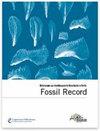下载PDF
{"title":"摩洛哥Anti-Atlas上Fezouata组早弗洛世(早奥陶世)头足类动物的古地理和古生态学","authors":"Björn Kröger, Bertrand Lefebvre","doi":"10.1002/mmng.201200004","DOIUrl":null,"url":null,"abstract":"<p>In the central Anti-Atlas (Morocco), the Early Ordovician succession consists of about 1000 m of fossiliferous argillites and siltstones. The Upper Fezouata Formation (Floian) contains a comparatively rich and abundant cephalopod association. A small collection of these cephalopods is described herein for the first time. The cephalopods are interpreted as autochthonous or parautochthonous, representing a fauna, which originally lived nektobenthically in the open water above the sediments or related to the sea bottom. The cephalopod associations of the Upper Fezouata Formation are similar to other contemporaneous assemblages known from higher palaeolatitudes and associated with deeper depositional settings and in siliciclastically dominated deposits. They are composed almost exclusively of slender orthocones, in this case predominantly of <i>Destombesiceras zagorense</i> n. gen., n. sp., which is interpreted as an early discosorid. <i>Bathmoceras australe</i> Teichert, 1939 and <i>Bathmoceras taichoutense</i> n. sp. from the Upper Fezouata Formation are at present the earliest unambiguous occurrences of bathmocerid cephalopods. Epizoans on the shell of a specimen of <i>Rioceras</i> are the earliest evidence of bryozoans growing as potential hitchhikers on cephalopod shells, indicating an early exploitation of a pseudoplanktonic lifestyle in this phylum. (© 2012 WILEY-VCH Verlag GmbH & Co. KGaA, Weinheim)</p>","PeriodicalId":55147,"journal":{"name":"Fossil Record","volume":"15 2","pages":"61-75"},"PeriodicalIF":1.4000,"publicationDate":"2012-08-03","publicationTypes":"Journal Article","fieldsOfStudy":null,"isOpenAccess":false,"openAccessPdf":"https://sci-hub-pdf.com/10.1002/mmng.201200004","citationCount":"31","resultStr":"{\"title\":\"Palaeogeography and palaeoecology of early Floian (Early Ordovician) cephalopods from the Upper Fezouata Formation, Anti-Atlas, Morocco\",\"authors\":\"Björn Kröger, Bertrand Lefebvre\",\"doi\":\"10.1002/mmng.201200004\",\"DOIUrl\":null,\"url\":null,\"abstract\":\"<p>In the central Anti-Atlas (Morocco), the Early Ordovician succession consists of about 1000 m of fossiliferous argillites and siltstones. The Upper Fezouata Formation (Floian) contains a comparatively rich and abundant cephalopod association. A small collection of these cephalopods is described herein for the first time. The cephalopods are interpreted as autochthonous or parautochthonous, representing a fauna, which originally lived nektobenthically in the open water above the sediments or related to the sea bottom. The cephalopod associations of the Upper Fezouata Formation are similar to other contemporaneous assemblages known from higher palaeolatitudes and associated with deeper depositional settings and in siliciclastically dominated deposits. They are composed almost exclusively of slender orthocones, in this case predominantly of <i>Destombesiceras zagorense</i> n. gen., n. sp., which is interpreted as an early discosorid. <i>Bathmoceras australe</i> Teichert, 1939 and <i>Bathmoceras taichoutense</i> n. sp. from the Upper Fezouata Formation are at present the earliest unambiguous occurrences of bathmocerid cephalopods. Epizoans on the shell of a specimen of <i>Rioceras</i> are the earliest evidence of bryozoans growing as potential hitchhikers on cephalopod shells, indicating an early exploitation of a pseudoplanktonic lifestyle in this phylum. (© 2012 WILEY-VCH Verlag GmbH & Co. KGaA, Weinheim)</p>\",\"PeriodicalId\":55147,\"journal\":{\"name\":\"Fossil Record\",\"volume\":\"15 2\",\"pages\":\"61-75\"},\"PeriodicalIF\":1.4000,\"publicationDate\":\"2012-08-03\",\"publicationTypes\":\"Journal Article\",\"fieldsOfStudy\":null,\"isOpenAccess\":false,\"openAccessPdf\":\"https://sci-hub-pdf.com/10.1002/mmng.201200004\",\"citationCount\":\"31\",\"resultStr\":null,\"platform\":\"Semanticscholar\",\"paperid\":null,\"PeriodicalName\":\"Fossil Record\",\"FirstCategoryId\":\"89\",\"ListUrlMain\":\"https://onlinelibrary.wiley.com/doi/10.1002/mmng.201200004\",\"RegionNum\":4,\"RegionCategory\":\"地球科学\",\"ArticlePicture\":[],\"TitleCN\":null,\"AbstractTextCN\":null,\"PMCID\":null,\"EPubDate\":\"\",\"PubModel\":\"\",\"JCR\":\"Q3\",\"JCRName\":\"Earth and Planetary Sciences\",\"Score\":null,\"Total\":0}","platform":"Semanticscholar","paperid":null,"PeriodicalName":"Fossil Record","FirstCategoryId":"89","ListUrlMain":"https://onlinelibrary.wiley.com/doi/10.1002/mmng.201200004","RegionNum":4,"RegionCategory":"地球科学","ArticlePicture":[],"TitleCN":null,"AbstractTextCN":null,"PMCID":null,"EPubDate":"","PubModel":"","JCR":"Q3","JCRName":"Earth and Planetary Sciences","Score":null,"Total":0}
引用次数: 31
引用
批量引用


